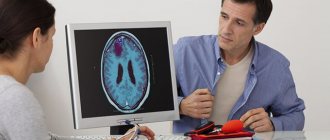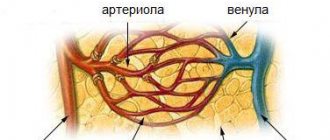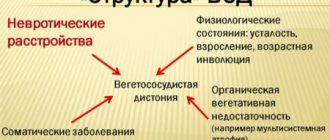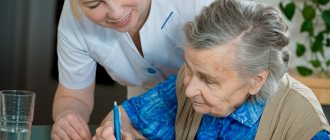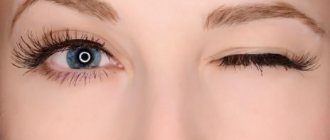Often people suffering VSD, symptoms this problem is mistaken for a disease and specialists are asked questions: “How to cope with ringing in the ears?”, “How can I get rid of osteochondrosis, pain in the spine?”, “Where to start treating panic attacks?”, “How can I cope with palpitations , dizziness, changes in blood pressure? etc. That is, in essence, they are interested in how to get rid of any symptom. And it often happens that a person reports: “I got rid of floaters in front of my eyes - I got dizzy”, “I got rid of breathing problems - a lump appeared in my throat, got rid of a lump in my throat - stomach problems appeared.”
Symptoms of neurosis and dystonia
As mentioned above, the signs of VSD and neurosis are similar, so often with neuroses a person complains of:
- anxiety;
- pressure surges;
- breathing problems;
- pain in the heart, feeling of heaviness in the chest, angina pectoris;
- abnormal heart rhythm in the form of increased or slow heartbeat;
- panic attacks (an attack is characterized by faintness, suffocation, numbness of the limbs, muscle pain and other symptoms);
- freezing in a static position;
- fear of dying;
- increased sweating, cold extremities, headaches;
- frequent urination;
- malfunction of the gastrointestinal tract, manifested by spasms of the intestines and esophagus, constipation or vomiting, heartburn, etc.;
- dry skin and mucous membranes in the mouth;
- general weak condition.
If a person is suspected of VSD and neurosis, he needs to undergo a series of examinations that will show what is actually happening in his body. As a rule, neurological pathologies can occur against the background of good health, in this case the results of tests and hardware diagnostics will show that everything is in order, but at the same time the symptoms of VSD or a neurotic condition will get worse and worse.
It is important to be able to recognize the problem in time and begin treatment. Self-medication following the example of neighbors or acquaintances should not be practiced, since a neurologist or psychiatrist selects medications and dosage individually. Often, doctors are faced with situations where patients do not comply with recommendations - when the condition worsens, they rely on tranquilizers and sedatives, and when they feel improvement, they stop therapy without completing it. In this case, relapses will definitely occur, and you cannot blame the doctor or attribute the failure to ineffective medications.
Definition of disorder
Autonomic neurosis is usually understood as a whole complex of symptoms that characterizes a disruption in the functioning of internal organs. It develops against the background of dysfunction of the autonomic nervous system. Most often, patients consult a doctor with complaints of pain in the heart, head and general weakness. However, diagnostic studies do not reveal structural changes. Patients may also experience a constant feeling of anxiety, insomnia and loss of energy. Most people associate them with weakened immunity, cardiac problems, or ordinary fatigue.
The pathological condition usually develops as a result of prolonged stress, excessive physical exertion or disruption of the work/rest regime. Bad habits or poor nutrition can affect its occurrence. Children also suffer from symptoms of autonomic neurosis. However, in them the occurrence of pathology is most often due to strong experiences associated with conflicts at school or with parents.
It is noteworthy that there is no mention of autonomic neurosis in any classification of diseases. This is not a disease, but a symptom complex that characterizes various disorders. Doctors are still arguing about the appropriateness of such a diagnosis. Therefore, there is no universal treatment. It all depends on the lesion and complaints directly from the patient himself.
Types of neuroses
In psychiatry, there are several types of neuroses. They may not have any special clinical manifestations, but doctors rely on their specificity to clarify the diagnosis. So, we can distinguish 4 variants of neurosis:
- hysterical. Characterized by a surge of emotions, it can be laughter or tears, screaming or hysteria, euphoria. What is happening is based on self-hypnosis, and ultimately is fraught with a stroke. Hysterical neurosis begins suddenly and also disappears unpredictably. More often, this type of pathology occurs in women, which is probably due to their hormonal balance;
- asthenic. Another name for the condition is neurasthenia. It is characterized by emotional swings, when excessive aggression is replaced by apathy and fatigue. A person is not able to perform any work, then we can say about intellectual tasks. The heart beats faster than necessary;
- obsessive states. Another name is psychasthenia. It is characterized by meaningless movements - twitching of limbs, shifting from foot to foot, etc. The person is prone to constant apathy, loses interest in surrounding events, and often thinks about suicide;
- depressive. It occurs in those people who do not know how to come to terms with changes, often become depressed, and are afraid of difficulties. Such people are categorical in their assessment of surrounding things and situations; they cannot overcome difficulties alone, which leads to mental trauma.
If you notice the symptoms listed above in yourself or your loved ones, you should definitely consult a neurologist or psychiatrist, since this condition will not go away on its own.
Types of neuroses
With vegetative-vascular dystonia, several types of neurotic conditions are usually distinguished:
- Depressive neurosis. In this case, patients’ interest in life becomes dull, they feel joyless, tired, and don’t want anything. This type of neurosis can be difficult to get rid of even with the help of a professional.
Neurotic depression
- Obsessive-compulsive disorder (psychasthenia). With this neurosis, for some reason a person systematically performs “extra” and “unnecessary” actions, for example, jerking his leg, fingering his hair.
- Asthenic neurosis (neurasthenia). Such patients have increased fatigue, they feel weak and drowsy, and have an increased need for rest. There are sudden mood swings from excessive irritability to complete indifference.
- Hysterical neurosis. Episodes of emotional outbursts predominate. In this case, the patient loses control over himself. Seizures may be complicated by paralysis, convulsions, or even hallucinations. The degree of self-suggestion matters. Women most often suffer from hysterics.
Further on how to defeat neurosis and VSD. In order to break the vicious circle
Treatment of neuroses and VSD
Therapy for any of the psycho-emotional disorders should be comprehensive. Both conditions need to be stopped, and the functioning of the nervous system needs to be restored so that there are no failures in the future. The main methods of treating VSD and neurosis are given below.
With the help of medications, it is possible to stop attacks of neurosis and improve the functioning of the central and autonomic nervous systems. Typically, the following groups of drugs are involved in therapy:
- sedatives. Given the large number of adverse reactions, such drugs are prescribed with caution;
- neuroprotectors. Medicines are aimed at normalizing cerebral circulation, protecting nerve fibers and stimulating blood circulation in capillaries;
- antidepressants. The drugs relieve anxiety and fear, help improve night sleep and eliminate panic attacks;
- medicines for heart and vascular diseases. They are prescribed for hypertension, arrhythmia, and tachycardia.
A desirable method of treating neuroses and dystonia is consultation with a psychotherapist. Some people believe that the help of a psychiatrist will be more effective than pills, and sometimes this happens. First of all, the doctor finds out why the patient is having attacks of neurosis or panic attacks, then explains to the patient what is causing the deterioration of the condition. Understanding how your body works is the first step to recovery. The specialist explains that both conditions are not fatal, and you just need to learn to suppress fear and cope with stress.
The next recommendation from doctors concerns physical therapy. You need to choose a set of exercises that increases muscle performance, improves the ability to withstand stress, and strengthens the heart and blood vessels. Moreover, during gymnastics and other physical activity a person’s mood improves, which in itself is a cure for these diseases. It is recommended to engage in one of the light types of sports - walking, yoga, swimming.
Physiotherapeutic procedures in the form of acupuncture, massage, breathing exercises, magnetic therapy and other therapeutic measures will help relax the nervous system, improve mood and well-being, and relieve tension.
Treatment
To ensure the normal functioning of the vascular system, an integrated approach to the process of vascular restoration is needed.
You need to review your diet, calm your nervous system, get adequate sleep, do regular physical exercise, and harden yourself. If necessary, only a doctor can prescribe medications.
Strengthening cerebral blood vessels
You can strengthen the walls of blood vessels and maintain their elasticity, and normalize blood circulation using the following methods:
- include a large amount of raw food in your daily diet: fruits, vegetables, herbs;
- exclude fatty meats, smoked meats, coffee, black tea, mayonnaise, chocolate, fried foods;
- consume a sufficient amount of clean drinking water (at least 1.5 liters);
- apply a contrasting perfume or wash your feet in cold water;
- physical exercise;
- massage.
How to relieve cerebral vascular spasm without medications
Zonal segmental massage
With relaxed palms, slowly stroke the forehead from the bridge of the nose to the temples, the face from the forehead to the chin, the back of the head from the neck to the shoulder blades, and the shoulder joints - first with the right hand on the left, then with the left palm on the right.
Use your fingertips to stroke your temples in a circular manner. Then we warm up the wrist joint, to do this we wrap it with a ring of the index and thumb of the opposite hand. At the same time, we do flexion and extension of the massaged arm at the elbow joint.
We finish the self-massage by rubbing the knee joint between the palms, repeating each technique 15-20 times.
Aromatherapy
If possible, self-massage and auto-training are complemented by aromatherapy; to do this, smear the lip under the nose with oil or tincture of lavender, valerian, jasmine, and mint.
Autogenic training
To enhance the antispasmodic effect of self-massage, it can be supplemented with autogenic training. As you exhale, we slowly repeat to ourselves the formula: “I am calm. I'm relaxed. I'm resting. The blood vessels relax. The spasm goes away. The heart beats calmly and evenly. I feel warmth in my head and heart.”
Self-massage is recommended several times a day for at least five minutes. You can do it in bed in the morning, and in the afternoon before going to work on a windy day, in case of a stressful situation.
Psychocorrection
It is based on cultivating easygoing nature, love of life, goodwill, tolerance, love of nature, art, and music. You should avoid “chewing” grievances and troubles, which disrupts sleep and leads to exhaustion of the nervous system.
Having an interesting job or creative hobby is important. Particular attention is paid to working with hands: needlework, painting, cooking, small repair work. Anything that helps develop fine motor skills of the fingers.
Since the nervous apparatus of the hands is closely connected with the subcortical vasomotor center in the brain. This work reduces excitation in this center, which maintains vasospasm.
If you find similar signs in yourself, we recommend that you familiarize yourself with the symptoms of cerebral atherosclerosis. For what reason intracranial pressure increases in infants, you can find out at the link provided.
Diet
Plant foods should predominate in the diet (particular importance should be given to walnuts, hawthorn, carrots, onions, honey). Limit the consumption of table salt, spices, and animal fats. Herbs that help well are motherwort, oregano, dried sweet grass, and sweet clover.
It is recommended to place a cotton pad with hop cones, crushed valerian root or mint under your nose at night. When overworked, honey and lemon are recommended. In case of bad weather - tea with motherwort, rose, oregano, lemon balm and frequent massage.
Prevention
Patients must understand that diseases associated with the functioning of the nervous system do not arise out of nowhere. If you know how to cope with stress and correct your view of problems, then you can avoid both the nervous diseases themselves and the complications associated with them.
Before starting treatment, it is necessary to exclude a number of other diseases that dystonia is disguised as. For example, during a panic attack, a person has a terrible migraine, his pulse quickens, he feels feverish and his blood pressure rises, and his heart hurts. And all these unpleasant symptoms are accompanied by the fear of dying. If this is neurology, then the worst thing that awaits the patient is fainting, and then only briefly. But in order to make sure that this is not a heart attack, not a hypertensive crisis or another pathology, after the condition has eased, you need to undergo an examination. They take tests for hormones, cardiogram, biochemical and general blood tests. The doctor may order other tests at his discretion.
If a person smokes or abuses alcohol, neglects walks in the fresh air and moves little, then no pills will help him get rid of neurology.
Treatment Options
Treatment of autonomic neurosis may not include psychotherapy. It is necessary to completely change your lifestyle, get rid of bad habits and switch to a balanced diet. All actions must be pre-coordinated with doctors. To completely cure vegetative-vascular neurosis, it is not enough to undergo drug therapy alone. Initially, the patient needs to adjust his sleep and rest patterns. It is strictly forbidden to be nervous, to be in stressful situations, it is necessary to observe occupational hygiene as much as possible.
The patient should strengthen the nervous system by eating only those foods that contain large amounts of magnesium and potassium. Even during the treatment period, you need to stabilize your blood pressure. To cleanse the body a little, the patient is allowed to drink an infusion of kombucha. The patient is prohibited from drinking alcohol or smoking. In order to calm the nervous system a little, it is allowed to use special aromatic oils, for example, chamomile, lavender and others. To strengthen blood vessels, as well as increase the body's resistance to neuroses, the patient needs to take a contrast shower.
All physical activity must be strictly dosed. If sudden panic attacks occur, they must be relieved using special sedative medications (infusion of motherwort, Corvalol).
Vegetative neurosis is treated similarly to vegetative-vascular neurosis. In cases where the cause of neurosis is a mental disorder, the help of a psychiatrist or psychoanalyst simply cannot be avoided.
Drug therapy affects the reasons that contributed to the fact that a person developed autonomic disorders, and also prevents further progression of the disease. Depending on how severe the disruption of the central nervous system is, sedatives may be prescribed that have a direct effect on the subcortical layers.
The prognosis for neurosis in all situations is quite favorable, with the exception of group 2 neurosis, in which irreversible organic changes occur in the neurons of the nervous system. As a rule, treatment of neuroses occurs on an outpatient basis (except for severe forms, when the patient needs to be in the clinic).
Preventive measures consist of constantly strengthening the nervous system and hardening the body. You should not ignore your health; it is better to prevent a disease than to waste energy on its treatment.
Vasospasm neurosis: cure, how it manifests itself, list, pills
Have you been struggling with HYPERTENSION for many years without success?
Head of the Institute: “You will be amazed at how easy it is to cure hypertension by taking it every day...
Read more "
Spasm of the blood vessels of the heart is considered a sharp and sudden narrowing of the lumen of the arteries, more precisely, the smooth muscle tissue that lines them. This tissue regulates blood flow in the coronary arteries. Such a spasm is temporary, however, it occurs in the form of angina pectoris, causing a person considerable discomfort.
- Causes
- Symptoms
- Diagnostics
- Treatment
- Consequences and prevention
A form of coronary insufficiency in which spasm leads to chest pain that occurs during rest is called resting angina. It is more common among women, even young ones. This condition may not depend on damage to the coronary arteries by the pathological process. Rest angina is less likely to cause severe complications or death than the usual form of the disease.
OUR READERS RECOMMEND!
Our readers successfully use ReCardio to treat hypertension. Seeing how popular this product is, we decided to bring it to your attention. Read more here...
Sudden narrowing of the lumen of the arteries of the heart
The etiology of spasms of the heart vessels is not fully understood. Some factors influencing its development, experts include increased activity of platelets, which are responsible for blood clotting. Of course, there are other reasons, which we will look at later. Regardless, any spasm is preceded by a calcium influx into the smooth muscle cells that line the arteries.
There is also such a thing as capillary angina. This syndrome predominantly affects women.
In this case, characteristic changes are observed on the ECG, but the coronary arteries are not blocked, and there are no signs of oxygen starvation of the heart muscle during stress or sports activities.
There are opinions that this form of spasms occurs as a result of impaired functioning of small vessels that are located near the coronary arteries.
Causes
Despite all of the above, it is possible to identify certain causes that lead to spasm and, accordingly, cause an attack of angina.
One of the causes of spasms is vascular atherosclerosis
- Atherosclerosis. Spasm and angina attacks occur when the lumen of the coronary arteries is narrowed by 50-70%. The more pronounced the stenosis, the more severe the course of the disease. The severity of attacks depends on the location and extent of the stenosis, as well as on the number of affected vessels.
- Gastrointestinal diseases.
- Infectious and allergic diseases.
- Rheumatoid and syphilitic vascular lesions.
In addition, it is possible to distinguish between removable and irreparable causes of spasm.
- Avoidable factors: hyperlipidemia, obesity, physical inactivity, smoking, diabetes mellitus, arterial hypertension, intoxication and anemia, psycho-emotional stress, increased blood viscosity, exposure to cold, the use of certain medications. Smoking increases the concentration of carboxyhemoglobin in the blood. This is a combination of hemoglobin and carbon monoxide, causing oxygen starvation of cells and spasm of the arteries.
- Unavoidable factors: age, gender, heredity.
Symptoms
The clinical sign is characterized by pressing or squeezing pain that occurs behind the sternum and radiates to the left shoulder blade or arm. Most often it occurs during emotional or physical stress, however, as we learned above, it can also occur at rest.
The threshold for the development of pain is determined by the degree of damage to the coronary arteries. If there is severe damage to three coronary arteries, spasm will occur even under minimal load. Angina at rest occurs mainly at night.
Attacks of this form of angina are longer and more intense. The pain increases more slowly than it disappears. It may be accompanied by the following symptoms:
- nausea;
- sweating;
- lack of air;
- dizziness;
- heartbeat.
As we already know, angina takes different forms, which are caused by spasm of the heart vessels, so it is worth recalling the classification of angina.
Angina pectoris. It is characterized by transient pain in the chest. They are caused by physical or emotional stress, which increases the metabolic demands of the heart muscle.
In this case, the pain disappears when taking nitroglycerin or at rest. Angina pectoris includes several types. For example, a spasm that occurs for the first time, that is, angina, lasts about one month or less from the first manifestation.
The prognosis and course are different, so this form may develop into another.
Stable angina lasts more than one month. It includes four functional classes. The first class is characterized by an attack that develops with excessive loads performed for a long time and intensively. In the second class, physical activity is limited, an attack occurs when climbing more than one floor and when walking more than 500 meters.
This usually occurs during bad weather and emotional excitement. In the third functional class, an attack occurs when climbing one floor and walking less than 200 meters. The fourth functional class is characterized by sharply reduced physical activity and the development of seizures at rest.
Spontaneous angina. It is caused only by a sudden spasm of the heart arteries. Attacks occur only at rest, early in the morning or at night.
Diagnostics
In order to recognize angina pectoris and the causes of spasm, it is necessary to carefully consider the patient’s complaints, namely the location, nature and duration of pain, as well as the conditions of their occurrence. It is important to conduct laboratory diagnostics. It includes blood tests for cholesterol, lipoproteins, triglycerides, electrolytes, and so on.
It is very important to determine cardiac troponin T and I markers, which indicate myocardial damage. It is very important to identify the cause of spasms and understand how they lead to angina attacks.
A number of other examinations should also be carried out.
- ECG. If the ECG is taken at the height of the attack, a decrease in the ST interval will be observed. A negative T wave will be noted in the precordial leads. Rhythm and conduction abnormalities will also be present.
- Daily ECG monitoring. Using this method, ischemic changes, if any, can be determined. Before an attack, the heart rate increases. In the case when the heart rate is normal, they speak of spontaneous angina caused by spasm of the heart vessels.
- EchoCG. With angina pectoris, ischemic local changes are detected.
- Bicycle ergometry. This is a test that shows what maximum load the patient can withstand. The load is created by the exercise bike until the submaximal heart rate is reached. At this time, an ECG is recorded.
- Diagnostic coronary angiography. It is carried out in order to assess the degree, location and extent of arterial damage.
All the results obtained from these examinations make it possible to distinguish spasms of the heart vessels from other diseases and understand their causes.
Treatment
Treatment is aimed at relieving spasm. It is very important to prevent attacks and complications of angina pectoris. As soon as an attack of angina occurs, it is necessary to take nitroglycerin. It can be taken in the form of a tablet or in the form of an alcohol solution; one or two drops of a one percent solution on a piece of sugar should be kept in the mouth until completely dissolved.
Usually the pain stops after a couple of minutes. If the attack cannot be stopped, nitroglycerin can be taken again, observing an interval of three minutes. However, you should not take this drug more than three times, as this contributes to a sharp decrease in blood pressure.
If severe angina develops, your doctor may recommend surgery. This includes balloon angioplasty or coronary artery bypass surgery.
- Coronary artery bypass grafting is a surgical intervention based on the implantation of a blood vessel into a blocked vascular area to restore blood flow. You could say that this is creating a workaround. For transplantation, leg veins or retrosternal arteries are used.
- Angioplasty involves the use of a catheter with a small balloon at the end. The catheter is advanced to the site of narrowing of the artery, where the balloon is stretched and inflated, thereby eliminating the spasm.
However, in order to increase the duration of angioplasty, a method called vascular stenting has been developed.
A stent is a metal tubular mesh that expands in the artery and acts as a kind of frame. This prevents the artery from narrowing and spasming.
All of the above operations have been carried out for quite a long time, but some patients develop restenosis, that is, repeated narrowing of the vessel. There are two reasons for this.
- During angioplasty, the artery stretches and opens, however, its walls are elastic, so subsequently it can narrow again.
- Development of scar tissue. Usually the amount is small, but sometimes it is significant, so blood flow may again be obstructed.
The stent is a foreign body, and therefore can cause a negative reaction in the body in those patients who were implanted with a conventional metal stent. This reaction takes place in the form of vasoconstriction. However, this problem can be avoided by using other stents that are coated with a drug-eluting polymer.
Consequences and prevention
Spasm leading to the development of angina pectoris significantly increases the risk of myocardial infarction. The most dangerous thing that can happen is death. That is why it is necessary to be examined in time and pay attention to any symptoms. It is also very important to prevent spasms and the development of angina pectoris.
Basic methods of prevention:
- to give up smoking;
- blood pressure control;
- limiting physical and emotional stress;
- limiting the consumption of alcoholic beverages;
- proper nutrition;
- moderate physical activity.
By following these simple rules, you can avoid problems not only with blood vessels, but also with other organs. Let's not forget that most often our health is in our hands!
Source: https://nedostatochnost.lechenie-gipertoniya.ru/simptomyi/nevroz-spazm-sosudov/



